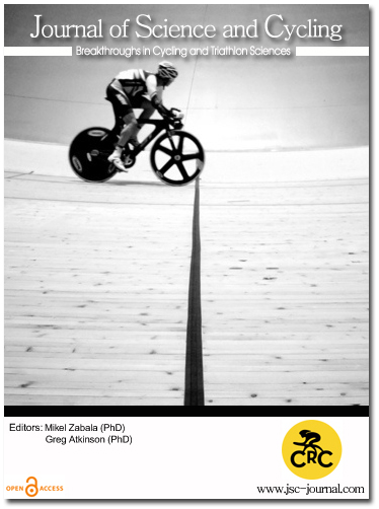Power distribution, performance changes and bioelectrical impedance properties during the preparation period of professional cyclists
Abstract
Introduction
Athletic training improves exercise performance and modifies body composition. The influence of training volume and intensity during the general preparation period on performance and body composition has not been extensively studied in cyclists. Thus, this study aimed to investigate performance changes as well as changes in the body composition and bioelectrical impedance properties during a three-month training period with varying training volume and intensity.
Methods
Eight professional road cyclists participated in the study. After a one-month off season and before starting with their seasonal preparation period, bioelectrical impedance vector analyses (BIVA) and skinfold thickness measurements (9 sites) were performed at T0, T10 (after a month from T0), T40, T68. The bioelectrical values analyzed were Reactance/height (Xc/h), Impedance(IMP). Training volume and intensity (4 zones: <100, 100-300, 300-500, >500, Metcalfe et al. 2016) as well as the Training Stress Score (TSS) were monitored at T10, T40, T68. Detailed data acquisition was done only for the last ten days during the first period. We used training data with the Training Peaks Software (Peaksware LLC, Lafayette, CO, USA) and determined the functional threshold power (FTP), the functional reserve capacity (FRC) and the peak power during 5 s (P5s), 5 min (P5min), 20 min (P20min) and 60 min (P60min).
Results
Total training volume decreased from T40 to T68(distance: 2,720±270 km to 2,060±200 km; climbing: 30,400±9324 m to 16,560±6,690 m; time: 6,142±1100 min to 3,890±90 min; external work: 63,035±10,385 J to 42,628±4,338 J; p<0.05) as well as TSS (5757±1550 AU to 3370±777 AU).
The different intensity zones are shown in Table 1. The performance parameters improved at T40 with respect to T10 (FTP: 4.97±0.44 to 5.43±0.27 watts/kg, P5s: 12.40±3.73 to 13.97±2.16, P5min: 6.16±0.44 to 6.87±0.48, P20min: 4.68±0.48 to 5.14±0.32, P60min: 3.88±0.27 to 4.19±0.24 watts/kg, p<0.05) whereas at T68 a decline was found for P5min (5.87±0.74 watts/kg), P20min (4.65±0.57 watts/kg) and P60min (3.55±0.40 watts/kg). TSS decreased at T40 to T68 (5757±1500 to 3370±777, p<0.05). At T10, body weight (68.0±4.4 to 67.1±5,1 p<0.05) and sum of skinfold (54.5±12.5, p<0.05 decreased from T0 whereas vector length tended to increase (272±18 to 277±23 Ω/m, p=0.09). Vector length tended to increase (269±24 to 278±30 Ω/m, p=0.09), Xc/h and phase angle improved (35.0±3.8 to 37.3±4.1 Ω/m and 7.4±0.7 to 7.8±0.9°, p<0.05, respectively) and sum of skinfolds decreased (54.5±12.5 to 43.3±10.9 mm, p<0.05) over the 4-month training period. Moreover, significant negative correlations were found between impedance and weight and external workload (IMP with Body Weight r=-.736 p=0.001; ΔIMP with ΔKj r=-,571 p=0.004; ΔIMP with ΔKm R=-.567 p=0.004; ΔIMP with ΔTSS r=-.466 p=0.022).
Discussion
The present data show that the external workload decreased slightly from T40 to T68. At T10 training minutes were not analyzed as only data for 10 days have been assessed. Over the entire observational period, intensity distribution (% time in each zone) remained essentially the same, though at T40 compared to month T10 a slightly lower portion in the <100 watts zone and a slightly greater amount of >500 watts training was completed. The phase angle and the reactance that are biomarkers of muscle function (Norman et al. 2012) improved over the 68 days of training period. Interestingly, at T10, vector length tended to increase which indicates that body water content declined (Lukaski 2013; Piccoli et. 1994) while body weight decreased. Conversely, at T40, vector length slightly decreased that indicates body water volume was restored, whereas no significant changes in body weight occurred. We hypothesize that the body fluid and weight losses from T0 are due to a negative energy balance (hypocaloric diet + increased energy expenditure). Heydenreich et al. (2017) noted that during the preparation phase the athletes often reduce their energy intake to reduce their body weight. After increasing training volume and intensity (T40), body fluid increased which is in accordance with reports showing that intensified training and increasing physical strain leads to body fluid gains (Pollastri et al. 2016; Sawka et al. 2000). We conclude that bioelectrical impedance is a practical method to monitor body water changes in response to physical training.
Downloads
Published
How to Cite
Issue
Section
Copyright (c) 2018 Journal of Science and Cycling

This work is licensed under a Creative Commons Attribution-NonCommercial 4.0 International License.
Authors contributing to Journal of Science and Cycling agree to publish their articles under a Creative Commons CC BY-NC-ND license, allowing third parties to copy and redistribute the material in any medium or format, and to remix, transform, and build upon the material, for any purpose, even commercially, under the condition that appropriate credit is given, that a link to the license is provided, and that you indicate if changes were made. You may do so in any reasonable manner, but not in any way that suggests the licensor endorses you or your use.
Authors retain copyright of their work, with first publication rights granted to Cycling Research Center.






